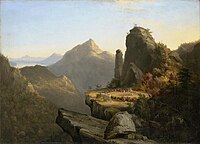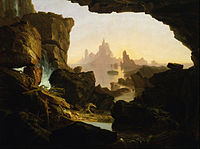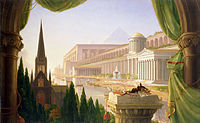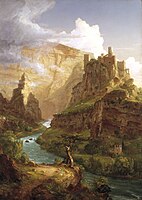Thomas Cole | |
|---|---|
 Thomas Cole, 1846 | |
| Born | February 1, 1801 Bolton, Lancashire, England |
| Died | February 11, 1848 (aged 47) Catskill, New York, United States of America |
| Nationality | English, American |
| Known for | Painting Medium/Media: Oil on Canvas |
Notable work | The Titan's Goblet (1833), The Course of Empire (1833–36), The Oxbow (1836), The Voyage of Life (1842) |
| Movement | Hudson River School |

Thomas Cole (February 1, 1801 – February 11, 1848) was an English-born American painter known for his landscape and history paintings. one of the major 19th-century American painters, he is regarded as the founder of the Hudson River School,[1][2] an American art movement that flourished in the mid-19th century. Cole's work is known for its romantic portrayal of the American wilderness.[3]
허드슨 강파를 창시한 미국의 낭만파 풍경화가.
그의 가족은 영국에서 미국 필라델피아로 이주했다가, 오하이오 주 스튜번빌에 정착했다. 콜은 스타인이라는 떠돌이 초상화가에게 처음 그림을 배운 뒤 펜실베이니아 미술 아카데미에서 2년 동안 공부했다. 1825년 뉴욕의 한 가게 진열장에 놓여 있던 콜의 풍경화 몇 점이 존 트럼벌 대령과 화가인 애셔 B. 듀런드의 관심을 끌었다.
이들은 그의 작품을 사들이는 한편 장차 그의 성공을 확신하면서 후원자를 소개해주었다. 1826년 콜은 허드슨 강 서쪽 연안에 있는 뉴욕 주 캐츠킬이라는 마을에 정착했다. 그는 이 마을을 중심으로 하여 미국 북동부지역을 주로 걸어서 두루 돌아다니며 풍경을 연필로 스케치했다. 그는 잦은 도보 여행에서 그린 이 스케치를 바탕으로 겨울에는 화실에서 작품으로 완성했다. 대표적인 풍경화 가운데 〈강의 물굽이 The Ox-Bow〉(1846, 뉴욕 메트로폴리탄 미술관)는 매사추세츠 주에서 그린 연필 스케치를 토대로 한 것이었다. 허드슨 강 유역의 풍경을 경외하는 마음으로 기록한 콜의 풍경화는 북아메리카의 숲에서 느낄 수 있는 고적함과 신비감을 충실히 반영했다. 콜은 눈으로 직접 본 풍경을 세부까지 자세하게 사실적으로 그리는 한편 대담한 명암효과를 이용하여 상상 속에 존재하는 웅장하고 극적인 풍경도 창조할 수 있었다. 그의 작품에 등장하는 인간은 항상 주변 풍경의 장엄함에 압도당한 모습으로 나타난다.
콜은 1829~32, 1841~42년을 외국(주로 이탈리아)에서 보냈으며 피렌체에서는 미국의 조각가인 호레이쇼 그리노와 함께 지냈다. 미국으로 돌아온 그는 〈제국의 행로 The Course of Empire〉(1836)라는 제목으로 5점의 거대한 연작 그림을 그렸다. 이 그림들은 볼네의 〈몰락, 또는 제국의 혁명에 관한 명상 Ruines, ou méditations sur les révolutions des empires〉(1791)을 바탕으로 인류의 진보를 우의적으로 그린 것이다.
〈인생 여정 The Voyage of Life〉(1839 시작)이라는 제목의 2번째 연작은 어린시절부터 노년에 이르는 인생의 여로를 4개의 상징적 장면으로 묘사하고 있다. 콜은 죽기 직전에 종교적 성격의 〈세계의 십자가 The Cross of the World〉라는 또다른 연작을 그리기 시작했다. 콜이 죽은 이듬해에 듀런드는 콜을 추모해 그린 〈서로 마음이 맞는 사람들 Kindred Spirits〉(1849, 뉴욕 공립도서관)이라는 유명한 그림에서 콜과 시인인 윌리엄 쿨런 브라이언트의 우정에 경의를 표하고 있다.[다음 백과]
===============================================================
미국적 풍경화를 일군 허드슨강파의 창시자이다. 19세기 중반 토머스 콜이 주도한 허드슨강파는 광활한 미국의 풍경을 사실적이고 섬세하게 표현함으로써 낭만주의 풍경화의 전성기를 이끌었다.
영국 랭커셔 볼톤에서 태어난 그는 1818년 가족과 함께 미국으로 이주한 뒤 오하이오의 스터벤빌에서 성장했다. 무명작가 스타인에게서 초상화를 배웠지만, 초상화가로 두각을 나타내지 못하자 풍경화가로 방향을 틀었다. 1823년 피츠버그에 머물던 시절, 콜은 나무와 나뭇가지들을 세심하게 관찰하고 강렬한 터치로 그려내는 등 자연에 관심을 두었다.
1820년대 말 미국의 아름다운 경치를 캔버스에 재현하는 풍경화가로 명성과 부를 획득했지만, 그의 궁극적인 야망은 도덕적이고 종교적인 이미지를 담은 고차원의 풍경화를 표현하는 것이었다.
자연은 신이 빚어낸 위대한 창조물이라는 기독교적 가치관이 담긴 작품이 많은 이유는 그 때문이다. 특히 계절의 변화와 인간의 삶을 은유적으로 표현하는 등 신화적 분위기가 특징이다.
인류의 흥망성쇠를 5점의 연작으로 완성시킨 〈제국의 여정〉은 당시 뉴욕 화단을 전율시켰다. 〈순수의 시대〉를 시작으로 〈제국의 종말〉, 〈전원의 시대〉, 〈파국〉, 〈폐허〉로 구성된 〈제국의 여정〉 시리즈는 4년에 걸쳐 완성됐다. 이외에 대표작으로는 코코란 갤러리의 〈출발〉과 워싱턴 국립미술관의 〈귀환〉, 〈인생의 항해〉 등이 있다.
[글- 박진현 /출처-처음 만나는 미국 미술관]
===============================================================
Born in Bolton le Moors, Lancashire, in 1801, Cole emigrated with his family to the United States in 1818, settling in Steubenville, Ohio. At the age of 22, Cole moved to Philadelphia and later, in 1825, to Catskill, New York, where he lived with his wife and children until 1848.[4]
Cole found work early on as an engraver. He was largely self-taught as a painter, relying on books and by studying the work of other artists. In 1822, Cole started working as a portrait painter and later on, gradually shifted his focus to landscape.[5]
Painting
In New York, Cole sold five paintings to George W. Bruen, who financed a summer trip to the Hudson Valley where the artist produced landscapes featuring the Catskill Mountain House, the famous Kaaterskill Falls, the ruins of Fort Putnam, and two views of Cold Spring.[6][7] Returning to New York, he displayed five landscapes in the window of William Colman's bookstore; according to the New York Evening Post the two views of Cold Spring were purchased by Mr. A. Seton, who lent them to the American Academy of the Fine Arts annual exhibition in 1826. This garnered Cole the attention of John Trumbull, Asher B. Durand, and William Dunlap. Among the paintings was a landscape called View of Fort Ticonderoga from Gelyna. Trumbull was especially impressed with the work of the young artist and sought him out, bought one of his paintings, and put him into contact with a number of his wealthy friends including Robert Gilmor of Baltimore and Daniel Wadsworth of Hartford, who became important patrons of the artist.
Cole was primarily a painter of landscapes, but he also painted allegorical works. The most famous of these are the five-part series, The Course of Empire, which depict the same landscape over generations—from a near state of nature to consummation of empire, and then decline and desolation—now in the collection of the New York Historical Society and the four-part The Voyage of Life. There are two versions of the latter, one at the National Gallery in Washington, D.C., the other at the Munson-Williams-Proctor Arts Institute in Utica, New York. Among Cole's other famous works are The Oxbow (1836), The Notch of the White Mountains, Daniel Boone at his cabin at the Great Osage Lake, and Lake with Dead Trees (1825) which is at the Allen Memorial Art Museum.[8] He also painted The Garden of Eden (1828), with lavish detail of Adam and Eve living amid waterfalls, vivid plants, and deer.[9] In 2014, friezes painted by Cole on the walls of his home, which had been decorated over, were discovered.[10]
Cole influenced his artistic peers, especially Asher B. Durand and Frederic Edwin Church, who studied with Cole from 1844 to 1846. Cole spent the years 1829 to 1832 and 1841 to 1842 abroad, mainly in England and Italy.
Other work
Cole is best known for his work as an American landscape artist. In an 1836 [11] article on "American Scenery,"[12] he described his complex relationship with the American landscape in esthetic, emotional, and spiritual terms. He also produced thousands of sketches of varying subject matter. Over 2,500 of these sketches can be seen at The Detroit Institute of Arts.
In 1842, Cole embarked on a Grand Tour of Europe in an effort to study in the style of the Old Masters and to paint its scenery. Most striking to Cole was Europe's tallest active volcano, Mount Etna. Cole was so moved by the volcano's beauty that he produced several sketches and at least six paintings of it.[13] The most famous of these works is A View from Mount Etna from Taormina which is a 78-by-120-inch (1,980 by 3,050 mm) oil on canvas. Cole also produced a highly detailed sketch View of Mount Etna (pictured below) which shows a panoramic view of the volcano with the crumbling walls of the ancient Greek theatre of Taormina on the far right.
Cole was also a poet and dabbled in architecture, a not uncommon practice at the time when the profession was not so codified. Cole was an entrant in the design competition held in 1838 to create the Ohio Statehouse in Columbus, Ohio. His entry won third place, and many contend that the finished building, a composite of the first, second, and third-place entries, bears a great similarity to Cole's entry.[14]
Personal life
After 1827 Cole maintained a studio at the farm called Cedar Grove, in the town of Catskill, New York. He painted a significant portion of his work in this studio. In 1836, he married Maria Bartow of Catskill, a niece of the owner's, and became a year-round resident. Thomas and Maria had five children.[15] Cole's sister, Sarah Cole, was also a landscape painter; the two were close.
Additionally, Cole held many friendships with important figures in the art world including Daniel Wadsworth, with whom he shared a close friendship. Proof of this friendship can be seen in the letters that were unearthed in the 1980s by the Trinity College Watkinson Library. Cole emotionally wrote Wadsworth in July 1832: "Years have passed away since I saw you & time & the world have undoubtedly wrought many changes in both of us; but the recollection of your friendship... have never faded in my mind & I look at those pleasures as "flowers that never will in other garden grow-"[16] Thomas Cole died at Catskill on February 11, 1848. The fourth highest peak in the Catskills is named Thomas Cole Mountain in his honor.[17] Cedar Grove, also known as the Thomas Cole House, was declared a National Historic Site in 1999 and is now open to the public.[18]
Selected works
Imaginary scene from The Last of the Mohicans (1827)
Distant View of Niagara Falls (1830), Art Institute of Chicago
Romantic Landscape with Ruined Tower (1832–36), Albany Institute of History & Art
The Course of Empire: The Savage State (1836), New-York Historical Society
The Course of Empire: Consummation (1835–1836), New-York Historical Society
The Course of Empire: Desolation (1836), New-York Historical Society
The Fountain of Vaucluse (1841), Dallas Museum of Art
Temple of Segesta (1843), Museum of Fine Arts, Boston
A View of the Two Lakes and Mountain House, Catskill Mountains, Morning (c. 1844), Brooklyn Museum
Home in the Woods (1847), Reynolda House Museum of American Art
Prometheus Bound (1847), Fine Arts Museums of San Francisco
See also
'♣ 미술(美術) 마당 ♣ > - 화가[畵家]' 카테고리의 다른 글
| [프랑스]François-Hubert Drouais [프랑수아 위베르 두루에] (0) | 2019.06.10 |
|---|---|
| [프랑스 풍경화가]조제프 베르네 [Claude Joseph Vernet ] (0) | 2019.05.25 |
| [스위스 상징주의 화가]아놀드 뵈클린 [Arnold Böcklin] (0) | 2019.05.08 |
| [이탈리아- 상징주의 화가]Gaetano Previati (0) | 2019.05.07 |
| [영국]George Romney (0) | 2019.04.30 |

















